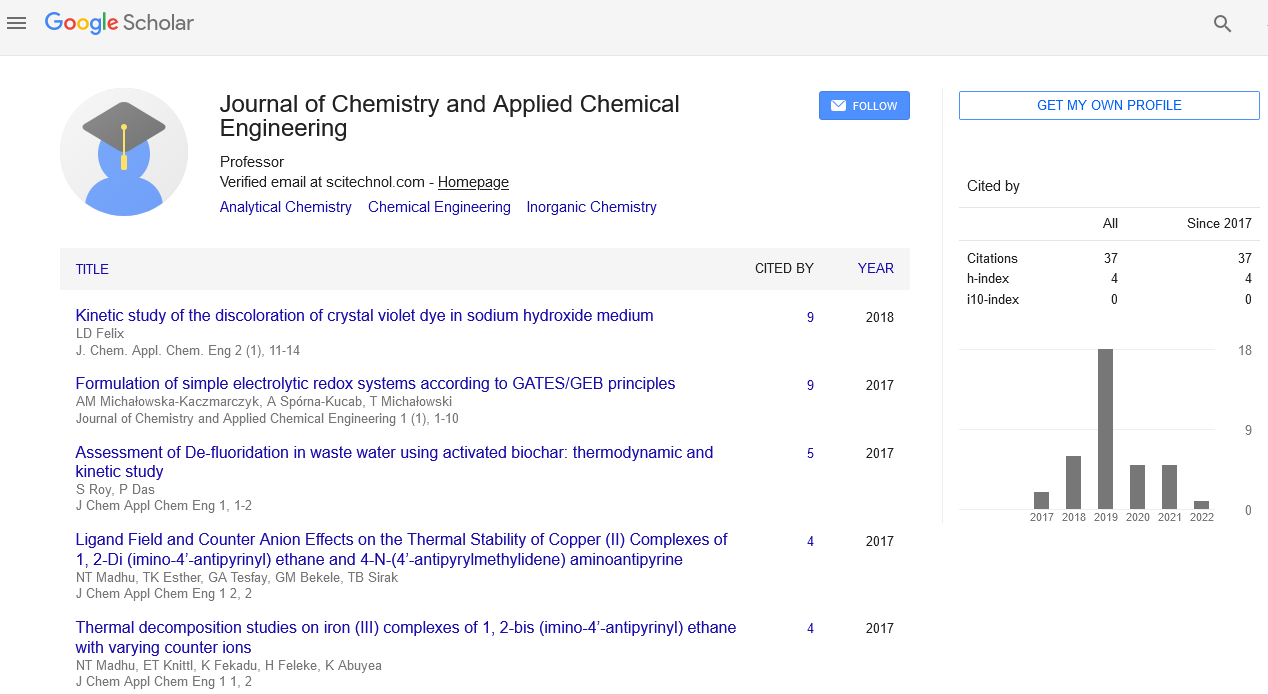Opinion Article, J Chem Appl Chem Eng Vol: 7 Issue: 1
Application of Ionic Liquids as Green Solvents for Organic Synthesis
Hikaro Dang*
1Department of Materials Molecular Science, Institute for Molecular Science (IMS), Okazaki, Japan
*Corresponding Author: Hikaro Dang
Department of Materials Molecular Science,
Institute for Molecular Science (IMS), Okazaki, Japan
E-mail: dang@hikaro-u.ac.jp
Received date: 01 March, 2023, Manuscript No. JCACE-23-93039;
Editor assigned date: 03 March, 2023, Pre QC No. JCACE-23-93039(PQ);
Reviewed date: 17 March, 2023, QC No. JCACE-23-93039;
Revised date: 24 March, 2023, Manuscript No. JCACE-23-93039(R);
Published date: 31 March, 2023, DOI: 10.4172/Jcace.1000e013
Citation: Dang H (2023) Application of Ionic Liquids as Green Solvents for Organic Synthesis. J Chem Appl Chem Eng 7:1.
Description
Organic synthesis is the branch of chemistry concerned with the construction of organic molecules from simpler starting materials. It involves the design and execution of chemical reactions to produce new molecules with desired properties, such as increased potency or selectivity in biological or industrial applications.
Organic synthesis can be broadly divided into two main categories: total synthesis and partial synthesis. Total synthesis involves the complete construction of a complex molecule from simple starting materials, while partial synthesis involves the modification of an existing molecule to produce a new compound with improved properties.
There are several methods of organic synthesis, including retrosynthetic analysis, which involves breaking down the target molecule into simpler fragments and designing a synthetic route to produce each fragment. Protective groups, reagents, catalysts, and modern techniques such as microwave-assisted synthesis and flow chemistry are also employed in organic synthesis to facilitate specific reactions or transformations.
Organic synthesis is widely used in drug discovery, where it is used to create novel compounds with therapeutic potential. It is also used in materials science to produce new polymers, dyes, and other materials with unique properties. Additionally, organic synthesis plays a major role in the development of new industrial chemicals, such as solvents and catalysts.
Ionic liquids are a type of green solvent that have gained significant attention in organic synthesis due to their unique properties. These solvents are composed entirely of ions, making them non-volatile, non-flammable, and generally stable under a wide range of conditions. As a result, they offer several advantages over traditional solvents in terms of safety, sustainability, and efficiency.
Ionic liquids are also non-toxic and non-flammable, making them safer to handle than many traditional organic solvents. They are also generally reusable, reducing waste and minimizing the environmental impact of organic synthesis.
Furthermore, the use of ionic liquids in organic synthesis has been shown to improve reaction rates, yields, and selectivity. This is because the unique properties of ionic liquids can stabilize reactive intermediates and facilitate the formation of desired products. In addition, the absence of water in many ionic liquids can help prevent unwanted side reactions, such as hydrolysis or oxidation.
One of the main advantages of ionic liquids is their low volatility and high thermal stability. They are non-volatile, which means they have low vapor pressures and therefore low emissions, making them more environmentally friendly than traditional solvents. In addition, ionic liquids are non-flammable and non-toxic, making them safer to handle than many traditional organic solvents.
Furthermore, ionic liquids can be easily tailored to specific applications by selecting specific cations and anions to optimize their properties for a given reaction. This allows for fine-tuning of ionic liquids to provide increased selectivity, improved reaction rates, and better yields.
Ionic liquids have a wide range of applications, including in the pharmaceutical industry, where they are used as green solvents for drug synthesis and formulation. They are also used in the petrochemical industry for the extraction and purification of chemicals and in the development of sustainable energy sources such as batteries and solar cells.
Overall, the use of ionic liquids as green solvents for organic synthesis has the potential to significantly reduce the environmental impact of chemical synthesis while improving safety and efficiency. As a result, they are increasingly being used in a range of applications, including drug discovery, materials science, and industrial chemistry.
 Spanish
Spanish  Chinese
Chinese  Russian
Russian  German
German  French
French  Japanese
Japanese  Portuguese
Portuguese  Hindi
Hindi 